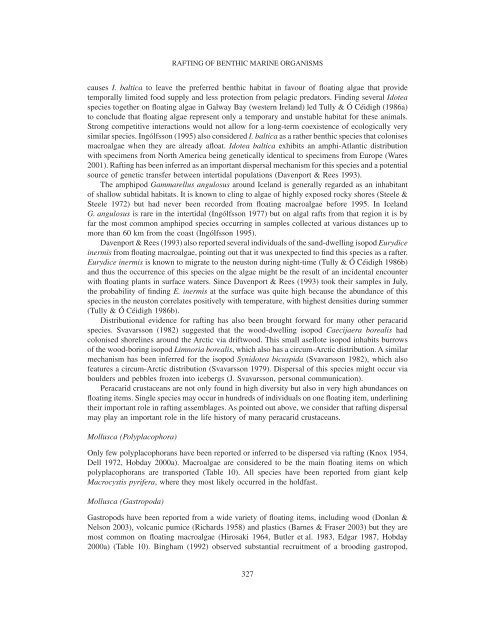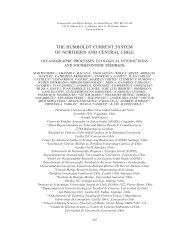The ecology of rafting in the marine environment - Bedim
The ecology of rafting in the marine environment - Bedim
The ecology of rafting in the marine environment - Bedim
Create successful ePaper yourself
Turn your PDF publications into a flip-book with our unique Google optimized e-Paper software.
RAFTING OF BENTHIC MARINE ORGANISMS<br />
causes I. baltica to leave <strong>the</strong> preferred benthic habitat <strong>in</strong> favour <strong>of</strong> float<strong>in</strong>g algae that provide<br />
temporally limited food supply and less protection from pelagic predators. F<strong>in</strong>d<strong>in</strong>g several Idotea<br />
species toge<strong>the</strong>r on float<strong>in</strong>g algae <strong>in</strong> Galway Bay (western Ireland) led Tully & Ó Céidigh (1986a)<br />
to conclude that float<strong>in</strong>g algae represent only a temporary and unstable habitat for <strong>the</strong>se animals.<br />
Strong competitive <strong>in</strong>teractions would not allow for a long-term coexistence <strong>of</strong> ecologically very<br />
similar species. Ingólfsson (1995) also considered I. baltica as a ra<strong>the</strong>r benthic species that colonises<br />
macroalgae when <strong>the</strong>y are already afloat. Idotea baltica exhibits an amphi-Atlantic distribution<br />
with specimens from North America be<strong>in</strong>g genetically identical to specimens from Europe (Wares<br />
2001). Raft<strong>in</strong>g has been <strong>in</strong>ferred as an important dispersal mechanism for this species and a potential<br />
source <strong>of</strong> genetic transfer between <strong>in</strong>tertidal populations (Davenport & Rees 1993).<br />
<strong>The</strong> amphipod Gammarellus angulosus around Iceland is generally regarded as an <strong>in</strong>habitant<br />
<strong>of</strong> shallow subtidal habitats. It is known to cl<strong>in</strong>g to algae <strong>of</strong> highly exposed rocky shores (Steele &<br />
Steele 1972) but had never been recorded from float<strong>in</strong>g macroalgae before 1995. In Iceland<br />
G. angulosus is rare <strong>in</strong> <strong>the</strong> <strong>in</strong>tertidal (Ingólfsson 1977) but on algal rafts from that region it is by<br />
far <strong>the</strong> most common amphipod species occurr<strong>in</strong>g <strong>in</strong> samples collected at various distances up to<br />
more than 60 km from <strong>the</strong> coast (Ingólfsson 1995).<br />
Davenport & Rees (1993) also reported several <strong>in</strong>dividuals <strong>of</strong> <strong>the</strong> sand-dwell<strong>in</strong>g isopod Eurydice<br />
<strong>in</strong>ermis from float<strong>in</strong>g macroalgae, po<strong>in</strong>t<strong>in</strong>g out that it was unexpected to f<strong>in</strong>d this species as a rafter.<br />
Eurydice <strong>in</strong>ermis is known to migrate to <strong>the</strong> neuston dur<strong>in</strong>g night-time (Tully & Ó Céidigh 1986b)<br />
and thus <strong>the</strong> occurrence <strong>of</strong> this species on <strong>the</strong> algae might be <strong>the</strong> result <strong>of</strong> an <strong>in</strong>cidental encounter<br />
with float<strong>in</strong>g plants <strong>in</strong> surface waters. S<strong>in</strong>ce Davenport & Rees (1993) took <strong>the</strong>ir samples <strong>in</strong> July,<br />
<strong>the</strong> probability <strong>of</strong> f<strong>in</strong>d<strong>in</strong>g E. <strong>in</strong>ermis at <strong>the</strong> surface was quite high because <strong>the</strong> abundance <strong>of</strong> this<br />
species <strong>in</strong> <strong>the</strong> neuston correlates positively with temperature, with highest densities dur<strong>in</strong>g summer<br />
(Tully & Ó Céidigh 1986b).<br />
Distributional evidence for <strong>raft<strong>in</strong>g</strong> has also been brought forward for many o<strong>the</strong>r peracarid<br />
species. Svavarsson (1982) suggested that <strong>the</strong> wood-dwell<strong>in</strong>g isopod Caecijaera borealis had<br />
colonised shorel<strong>in</strong>es around <strong>the</strong> Arctic via driftwood. This small asellote isopod <strong>in</strong>habits burrows<br />
<strong>of</strong> <strong>the</strong> wood-bor<strong>in</strong>g isopod Limnoria borealis, which also has a circum-Arctic distribution. A similar<br />
mechanism has been <strong>in</strong>ferred for <strong>the</strong> isopod Synidotea bicuspida (Svavarsson 1982), which also<br />
features a circum-Arctic distribution (Svavarsson 1979). Dispersal <strong>of</strong> this species might occur via<br />
boulders and pebbles frozen <strong>in</strong>to icebergs (J. Svavarsson, personal communication).<br />
Peracarid crustaceans are not only found <strong>in</strong> high diversity but also <strong>in</strong> very high abundances on<br />
float<strong>in</strong>g items. S<strong>in</strong>gle species may occur <strong>in</strong> hundreds <strong>of</strong> <strong>in</strong>dividuals on one float<strong>in</strong>g item, underl<strong>in</strong><strong>in</strong>g<br />
<strong>the</strong>ir important role <strong>in</strong> <strong>raft<strong>in</strong>g</strong> assemblages. As po<strong>in</strong>ted out above, we consider that <strong>raft<strong>in</strong>g</strong> dispersal<br />
may play an important role <strong>in</strong> <strong>the</strong> life history <strong>of</strong> many peracarid crustaceans.<br />
Mollusca (Polyplacophora)<br />
Only few polyplacophorans have been reported or <strong>in</strong>ferred to be dispersed via <strong>raft<strong>in</strong>g</strong> (Knox 1954,<br />
Dell 1972, Hobday 2000a). Macroalgae are considered to be <strong>the</strong> ma<strong>in</strong> float<strong>in</strong>g items on which<br />
polyplacophorans are transported (Table 10). All species have been reported from giant kelp<br />
Macrocystis pyrifera, where <strong>the</strong>y most likely occurred <strong>in</strong> <strong>the</strong> holdfast.<br />
Mollusca (Gastropoda)<br />
Gastropods have been reported from a wide variety <strong>of</strong> float<strong>in</strong>g items, <strong>in</strong>clud<strong>in</strong>g wood (Donlan &<br />
Nelson 2003), volcanic pumice (Richards 1958) and plastics (Barnes & Fraser 2003) but <strong>the</strong>y are<br />
most common on float<strong>in</strong>g macroalgae (Hirosaki 1964, Butler et al. 1983, Edgar 1987, Hobday<br />
2000a) (Table 10). B<strong>in</strong>gham (1992) observed substantial recruitment <strong>of</strong> a brood<strong>in</strong>g gastropod,<br />
327










